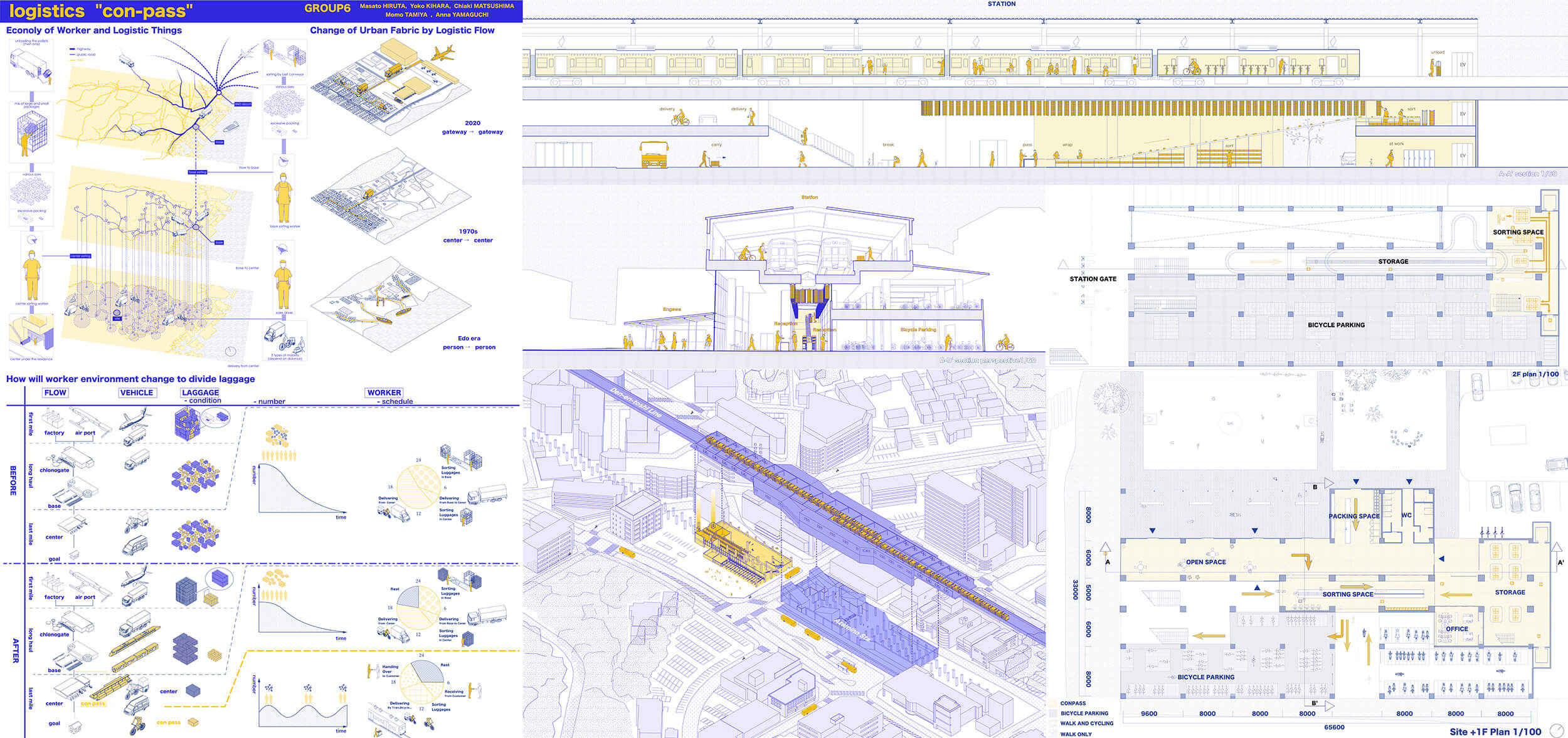In Jiyugaoka, a residential area is located at the top of the hill, and an elderly care facility and a school are located next to each other at the bottom. However, there is no interaction between these two facilities, and the elderly care facility is closed. Therefore, in order to allow children to enter the facility, a section of the building was manipulated and three plazas were created in plan. In this way, interaction between the elderly, school children, and local residents is created, and the elderly, who used to only receive care, are now actively involved.
Teacher: Noemi GOMEZ LOBO
Childcare / YIMBY
Low wages, long working hours, and an increasing burden due to the excessive demands of parents cause a shortage of childcare workers. There is also the NIMBY problem, where residents’ opposition to the construction of childcare facilities has forced them into poor conditions, such as under elevated railway tracks. All of these problems are caused by the fact that childcare is regarded as someone else’s business. A binary pits child welfare against economic activity and living conditions and excludes it. We tear away the asphalt that is paved by egoism. The soil opens up childcare, which used to be on the “other side” of the wall, to the city through activities such as composting, fieldwork and, children’s play in the soil.
2020_Non-Binary City
Noemi Gomez Lobo, 2020
The studio addresses multiple layers of binaries both found within the 20th century paradigm but also those arriving from the present reconsideration of everyday life due to the COVID-19 pandemic, the latter bringing forth a new binary, that of the essential versus non-essential worker. What is non-essential in essential work and what is necessary in the seemingly unnecessary? From the overuse of plastic packaging found in the Japanese supermarkets to our intrinsic need for emotional expression found in Performing arts, the nuances and interstices within seven different professions were explored through the architectural typologies that comprise the urban environment. The questions expanded to consider themes such as: merger of transportation of goods and transportation infrastructure to incorporate a social character; production of alcohol as part of running a Japanese style bar; housework as a collective and fun endeavor; caring for the elderly while respecting this demographic’s abilities and assets without ostracizing them from society; child caring as a welcomed activity within the neighborhood instead of a nuisance.After devising the “ecologies of livelihood” surrounding the types of work influenced by the methodology of Kon Wajiro’s Modernology, followed a second part of design proposals situated within Tokyo. A detailed section perspective in 1:50 along with axonometric representation and floor plans were produced. [Anastasia GKOLIOMYTI R2]
Super Market
Supermarkets supply us with large amounts of food. Along with that, supermarkets use a lot of plastic. However, the disposal of plastic is considered the responsibility of the consumer. To reduce the consumption of plastic more effectively, we need to change the way we sell the product itself. The food sales floor has changed dramatically with the changing times. The division of labor has increased, and the distance between customers and shoppers has grown further and further apart. Once again, we must find a way to shorten the distance that has separated us and at the same time reduce waste and increase communication.
Logistics
While highly efficient logistic systems have been established in recent years, the last mile is still carried by human hands. Now that the volume of packages is increasing due to the impact of COVID-19, it is necessary to rethink the working place of essential workers in logistics.
Our proposal is a transportation system for small packages that utilize the existing train network. By utilizing the existing infrastructure and involving local users in the first and last mile, the burden on Essential Workers will be distributed.
In logistics, where more and more packages are being shipped, utilizing existing stock will become more important than building huge warehouses.
We hope this video will give you an opportunity to look back on the current situation around the essential workers.
Izakaya
Izakaya was not considered as essential work during the covid-19 pandemic. Considering the change of working lifestyle such as working remotely from their houses, we have focused on the residential area. Researching the typologies of the Izakaya, we noticed the binary division between Primary and Tertiary industries. The selected residential area, Ookayama has many plum trees, which can be used for the production of Umeshu. This can help to dissolve the binary. According to the architectural typologies, we propose three types of new Izakaya combining with plum production: A: movable Izakaya kitchen car, B: Izakaya taxi which connect to the urban mobility, C: Izakaya park which has relationship with the outside.
Home maker
We focused on the time transition of homemaking space and found that in the past, we used to “share in nature”, but now “use machine by one person “.
So, our proposal is to create the pleasure of homemaking related to these binaries. We created bioclimatic design and homemaking network. We connected the original roads with doma and engawa to make it easier for people to enter. We also made devices to share and enjoy homemaking. Many kinds of people share household affairs and have interaction each other in this building. Finally, they can realize the interests of homemaking.
Performing Arts / Park-Yard
The preparation process of the drama is usually hidden inside a closed small theater, which is only opened during performances. In the Covid-19 situation, a very small amount of performance makes the actor’s life difficult to sustain.
Taking this as an opportunity, we hope to release parts of the functions of the preparation process into the park and the open ground floor space as a workshop, with the intention of opening and displaying the process of drama preparation and sharing skills in cooperation with surrounding residents.






